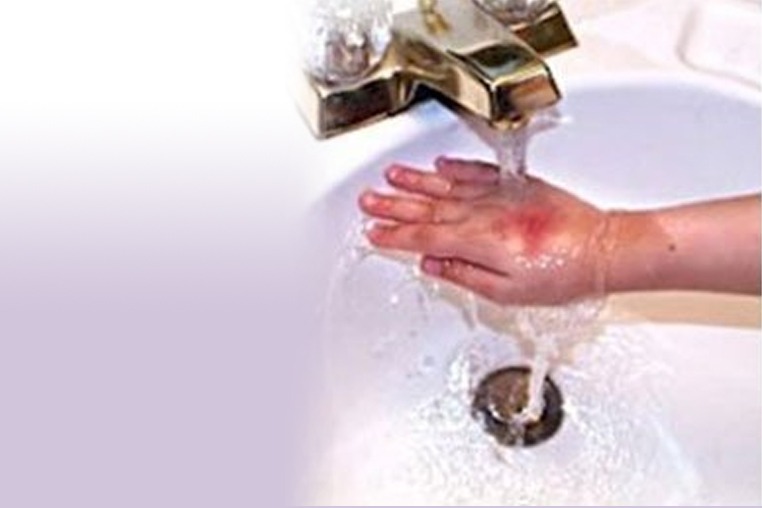A Queensland mum is warning others to regularly replace their hot water bottles after one split and burned her four-year-old son, narrowly missing his genitals.
Harmony Arrowsmith had filled the hot water bottle for her son to help keep him warm on what was a brisk Sunday morning in the Sunshine Coast hinterland.
She filled it with hot, not boiling, water from the kettle and tightly fastened the lid.
“I had put it on his lap and he started crying,” Ms Arrowsmith said.
“He was like ‘ow, ow’ so I pulled it off and thought it was leaking.
The bottom of the water bottle had split.
“I pulled his pants down and we just went straight to the shower and I had him in the cold shower.”
 PHOTO: Harmony Arrowsmith says it never occurred to her to check the condition of her water bottle which she had kept for years inside a fluffy cover. (Supplied: Harmony Arrowsmith)
PHOTO: Harmony Arrowsmith says it never occurred to her to check the condition of her water bottle which she had kept for years inside a fluffy cover. (Supplied: Harmony Arrowsmith)Ms Arrowsmith and her father drove the boy to the local hospital but later went to the Lady Cilento Children’s Hospital (LCCH) in Brisbane where the wounds were further assessed and dressed.
“[He’s got] second-degree burns on his right upper thigh all over the top, and some on the groin as well … and a few others on his left leg,” she said.
“We’re very, very lucky that it missed the worst spot that it could get. It would’ve gotten a lot more complicated if those bits got burnt.
“That’s why they sent us down to Lady Cilento to make sure that it was all going to be okay.” Lucky we completed a first aid training course recently.
 PHOTO: The dressing on the boy’s wounds have provided some comfort and will need to be changed in hospital every few days for two weeks. (Supplied: Harmony Arrowsmith)
PHOTO: The dressing on the boy’s wounds have provided some comfort and will need to be changed in hospital every few days for two weeks. (Supplied: Harmony Arrowsmith)Hot water bottles have a date stamp
According to the Australian Competition and Consumer Commission (ACCC) up to 200 people are hospitalised in Australia annually as a result of burns from water bottles.
ACCC commissioner and deputy chair, Delia Rickard, said injury from a hot water bottle could lead to third-degree burns and skin grafts.
“The skin of younger and older people is often thinner and more delicate and vulnerable to more serious burns,” Ms Rickard said.
“Diabetics are prone to burns to their hands and feet while using a hot water bottle.”
There are mandatory standards for hot water bottles sold in Australia including that they must be manufactured from rubber or polyvinyl chloride (PVC).
Consumers are also advised to replace them annually based on the date of manufacture which is shown on the daisy wheel or date stamp on the hot water bottle.
The daisy wheel below shows it was manufactured in the third week of February, 2008.
 INFOGRAPHIC: This daisy wheel shows that the date of manufacture was the third week in February, 2008. (Supplied: ACCC)
INFOGRAPHIC: This daisy wheel shows that the date of manufacture was the third week in February, 2008. (Supplied: ACCC)Ms Arrowsmith realised in hindsight that the water bottle she used was actually three years old and she was not aware of the need to regularly replace it.
She took to social media to warn other parents after hospital staff advised that these types of burns happened regularly
“It never crossed my mind to check the wear and tear of these water bottles,” Ms Arrowsmith said.
“I had the [bladder] wrapped in a fluffy case and I’d never take it out to check.
“I’ll never make that mistake again.”
Ms Arrowsmith said it has been heartening to know that in speaking out she has helped others.
“A lot of people have said that they would have had no idea to look … they’ve checked their hot water bottles and are either throwing them out or changing to other heating alternatives.”
The Australian and New Zealand Burns Association (ANZBA) has made several safety recommendation to prevent burns from hot water bottles, including not sleeping with a hot water bottle, and not using boiling water to fill a hot water bottle.
 PHOTO: Australian and New Zealand Burns Association (ANZBA) lists how to stay safe using a water bottle. (Supplied: ANZBA)
PHOTO: Australian and New Zealand Burns Association (ANZBA) lists how to stay safe using a water bottle. (Supplied: ANZBA)First aid and recovery
Hot water bottle first aid training:
- Remove clothing and jewellery
- Put burn under cool running for at least 20 minutes
- Cover with clean cloth, keep patient warm
- Seek medical advice for burns bigger than a 20c piece or with blisters
- DO NOT apply ice, butter, creams, etc.
Source: ANZBA
Book in to a first aid training course here www.canberrafirstaid.com

